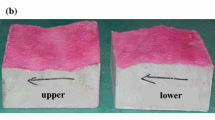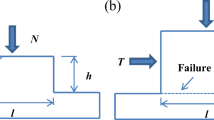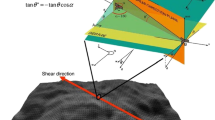Abstract
The shear behavior of rock joints is important in solving practical problems of rock mechanics. Three group rock joints with different morphologies are made by cement mortar material and a series of CNL (constant normal loading) shear tests are performed. The influences of the applied normal stress and joint morphology to its shear strength are analyzed. According to the experimental results, the peak dilatancy angle of rock joint decreases with increasing normal stress, but increases with increasing roughness. The shear strength increases with the increasing normal stress and the roughness of rock joint. It is observed that the modes of failure of asperities are tensile, pure shear, or a combination of both. It is suggested that the three-dimensional roughness parameters and the tensile strength are the appropriate parameter for describing the shear strength criterion. A new peak shear criterion is proposed which can be used to predict peak shear strength of rock joints. All the used parameters can be easily obtained by performing tests.
Similar content being viewed by others
References
BARTON N. Review of a new shear-strength criterion for rock joints [J]. Engineering Geology, 1973, 7(4): 287–332.
BARTON N, CHOUBEY V. The shear strength of rock joint in theory and practice [J]. Rock Mechanics, 1977, 10(1): 1–54.
MAKSIMOVIC M. New description of the shear strength for rock joints [J]. Rock Mechanics and Rock Engineering, 1992, 25(4): 275–284.
KULATILAKE P H S W, SHOU G, HUANG T H, MORGAN R M. New peak shear strength criteria for anisotropic rock joints [J]. International Journal of Rock Mechanics and Mining Sciences & Geomechanics Abstracts, 1995, 32(7): 673–697.
ZHAO J. Joint surface matching and shear strength part b: JRC-JMC shear strength criterion [J]. International Journal of Rock Mechanics and Mining Sciences, 1997, 34(2): 179–185.
HOMAND F, BELEM T, SOULEY M. Friction and degradation of rock joint surfaces under shear loads [J]. International Journal for Numerical and Analytical Methods in Geomechanics, 2001, 25(10): 973–999.
GRASSELLI G. Shear strength of rock joints based on quantified surface description [J]. Rock Mechanics and Rock Engineering, 2006, 39(4): 295–314.
TANG Z C, XIA C C, SONG Y L, LIU T. Discussion about Grasselli peak shear strength criterion for rock joints [J]. Journal of Rock Mechanics and Engneering, 2012, 31(2): 356–364. (in Chinese)
XIA C C, SONG Y L, TANG Z C, SONG Y J. Shear strength and morphology characteristic evolution of joint surface under cyclic loads [J]. Journal of Central South University: Science and Technology, 2012, 43(9): 3589–3594. (in Chinese)
XIA C C, TANG Z C, XIA W M, SONG Y L. New peak shear strength criterion of rock joints based on quantified surface description [J]. Rock Mechanics and Rock Engineering, 2014, 47: 387–400.
XIA C C, WANG W, DING Z Z. Development of three-dimensional TJXW-3D-typed portable rock surface topography [J]. Journal of Rock Mechanics and Engneering, 2008, 27(7): 1502–1512. (in Chinese)
TSE R, CRUDEN D M. Estimating joint roughness coefficients [J]. Internatinal Journal of Rock Mechanics and Mining & Geomechanics Abstract, 1979, 16(5): 303–307.
BEER A J, STEAD D, COGGAN J S. Estimation of the joint roughness coefficient (JRC) by visual [J]. Rock Mechanics and Rock Engineering, 2002, 35(1): 65–74.
HONG E S, LEE J S, LEE I M. Underestimation of roughness in rough rock joints [J]. International Journal for Numerical and Analytical Methods in Geomechanics, 2008, 32(11): 1385–1403.
TATONE B S A, GRASSELLI G. A new 2D discontinuity roughness parameter and its correlation with JRC [J]. International Journal of Rock Mechanics and Mining Sciences, 2010, 47(8): 1391–1400.
BELEM T, HOMAND F, SOULEY M. Quantitative parameters for rock joint surface roughness [J]. Rock Mechanics and Rock Engineering, 2010, 33(4): 217–242.
GRASSELLI G, WIRTH J, EGGER P. Quantitative 3D description of a rough surface and parameter evolution with shearing [J]. International Journal of Rock Mechanics and Mining Sciences, 2002, 39(6): 789–800.
TATONE BSA, GRASSELLI G. A method to evaluate the three-dimensional roughness of fracture surfaces in brittle geomaterials [J]. Review of Science Instrument, 2009, 80(12): 125110.
YANG ZY, TAGHICHIAN A, HUANG G D. On the applicability of self-affinity concept in scale of three-dimensional rock joints [J]. Internatinal Journal of Rock Mechanics and Mining, 1997, 48(7): 1173–1187.
PARK J W, SONG J J. Numerical simulation of a direct shear test on a rock joint using a bonded-particle model [J]. Internatinal Journal of Rock Mechanics and Mining, 2009, 46(8): 1315–1328.
GHAZVINIAN A H, AZINFAR M J, VANEGHI G R. Importance of tensile strength on the shear behavior of discontinuities [J]. Rock Mechanics and Rock Engineering, 2012, 45(3): 349–359.
BAHAADDINI M, SHARROCK G, HEBBLEWHITE B K. Numerical direct shear tests to model the shear behaviour of rock joints [J]. Computers and Geotechnics, 2013, 51(1): 101–115.
TANG Z C, XIA C C, SONG Y L, FU P F. Analysis of peak dilation strength and model of peak dilation angle for artificial joint [J]. Journal of Rock Mechanics and Engneering, 2012, 31(s1): 3038–3044. (in Chinese)
KUSUMI H, TERAOKA K, NISHIDA K. Study on new formulation of shear strength for irregular rock joints [J]. Internatinal Journal of Rock Mechanics and Mining, 1997, 34(3/4): 168.
Author information
Authors and Affiliations
Corresponding author
Additional information
Foundation item: Project(41130742) supported by the Key Program of National Natural Science Foundation of China; Project(2014CB046904) supported by the National Basic Research Program of China; Project(2011CDA119) supported by Natural Science Foundation of Hubei Province, China; Project(40972178) supported by the General Program of National Natural Science Foundation of China
Rights and permissions
About this article
Cite this article
Tang, Zc., Liu, Qs. & Huang, Jh. New criterion for rock joints based on three-dimensional roughness parameters. J. Cent. South Univ. 21, 4653–4659 (2014). https://doi.org/10.1007/s11771-014-2473-7
Received:
Accepted:
Published:
Issue Date:
DOI: https://doi.org/10.1007/s11771-014-2473-7




